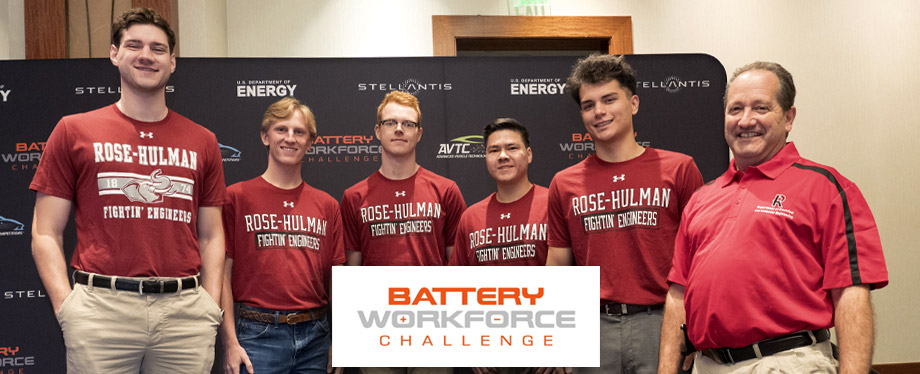
Rose-Hulman students and faculty are developing innovative battery technology that will enhance the expanding electric vehicle industry through involvement in the Battery Workforce Challenge.
Recently launched by the U.S. Department of Energy (DOE) and Stellantis, the Battery Workforce Challenge Competition tasks 12 North American universities plus vocational schools to design, build, test, and integrate an advanced electric vehicle battery into a future Stellantis vehicle.
Rose-Hulman was the only college from Indiana accepted for this competition after invitations were sent to institutions across the continent.
DOE has set a bold target to address the climate crisis that puts the nation on a path to achieve net-zero emissions, economy-wide, by 2050 for the benefit of all Americans. Officials point out that key elements toward achieving this goal are the design and development of advanced batteries to electrify the transportation and energy sectors. The Battery Workforce Challenge Program seeks to build a highly skilled domestic workforce with the hands-on experience and knowledge needed for in-demand positions throughout the EV/battery industry.
Enhancing the Rose-Hulman team’s efforts will be the development of a partnership with Ivy Tech Community College’s School of Advanced Manufacturing, Engineering & Applied Sciences in Terre Haute. Industry partnerships will also be forged to assist students from both colleges throughout the next three years.
Rose-Hulman’s effort is being led by Marc Herniter, PhD, professor of electrical and computer engineering, and Zac Chambers, PhD, professor of mechanical engineering, and will involve current and future students from a variety of academic degree areas. They have also led past participation in U.S. Department of Energy ChallengeX, EcoCAR and EcoCAR2 competitions, which had former project members graduate to work within the automotive and sustainable energy industries.
Throughout the competition, Rose-Hulman and Ivy Tech students will design, build, test, and integrate an advanced electric vehicle battery pack into a Stellantis vehicle. The first two years will involve development of a functioning battery pack after following real-world industry milestones focused on battery design, simulation, controls development, testing, and vehicle integration and demonstration. The battery system will then be implemented into the vehicle during the third and final year of the competition, which will conclude with a performance review organized by a panel of industry professionals.
The Battery Workforce Challenge team will have designed, secure areas within Myers Hall, the Branam Innovation Center, and other laboratory workspace on campus, along with having accessibility to high-performance desktop computers for Computer Assisted Design and model simulations.